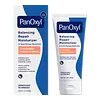What's inside
What's inside
 Key Ingredients
Key Ingredients

 Benefits
Benefits

 Concerns
Concerns

 Ingredients Side-by-side
Ingredients Side-by-side

Water
Skin ConditioningDimethicone
EmollientGlycerin
HumectantCetearyl Olivate
Acrylates/Beheneth-25 Methacrylate Copolymer
Caprylic/Capric Triglyceride
MaskingSorbitan Olivate
EmulsifyingPhenoxyethanol
PreservativeDimethicone/Vinyl Dimethicone Crosspolymer
Skin ConditioningSynthetic Beeswax
Emulsion StabilisingSodium Polyacrylate
AbsorbentDimethicone Crosspolymer
Emulsion StabilisingParfum
MaskingSodium Hydroxide
BufferingTrehalose
HumectantDimethiconol
EmollientChlorphenesin
AntimicrobialTocopheryl Acetate
AntioxidantYeast Extract
Skin ConditioningCarbomer
Emulsion StabilisingSodium Hyaluronate
HumectantEthylhexylglycerin
Skin ConditioningSodium Laureth Sulfate
CleansingC12-14 Pareth-12
EmulsifyingHydroxymethoxyphenyl Decanone
Skin ConditioningSodium Metabisulfite
AntioxidantMoringa Oleifera Seed Extract
Skin ConditioningWater, Dimethicone, Glycerin, Cetearyl Olivate, Acrylates/Beheneth-25 Methacrylate Copolymer, Caprylic/Capric Triglyceride, Sorbitan Olivate, Phenoxyethanol, Dimethicone/Vinyl Dimethicone Crosspolymer, Synthetic Beeswax, Sodium Polyacrylate, Dimethicone Crosspolymer, Parfum, Sodium Hydroxide, Trehalose, Dimethiconol, Chlorphenesin, Tocopheryl Acetate, Yeast Extract, Carbomer, Sodium Hyaluronate, Ethylhexylglycerin, Sodium Laureth Sulfate, C12-14 Pareth-12, Hydroxymethoxyphenyl Decanone, Sodium Metabisulfite, Moringa Oleifera Seed Extract
Water
Skin ConditioningGlycerin
HumectantNiacinamide
SmoothingHydroxyethyl Acrylate/Sodium Acryloyldimethyl Taurate Copolymer
Emulsion StabilisingLinoleic Acid
CleansingPhospholipids
Skin ConditioningSphingolipids
EmollientTocopherol
AntioxidantSodium Hyaluronate
HumectantCentella Asiatica Extract
CleansingAllantoin
Skin ConditioningPhenylpropanol
MaskingHydroxyacetophenone
AntioxidantPropanediol
SolventCaprylyl Glycol
EmollientOleic Acid
EmollientPalmitic Acid
EmollientPolysorbate 60
EmulsifyingSorbitan Isostearate
EmulsifyingStearic Acid
CleansingTetrasodium Glutamate Diacetate
1,2-Hexanediol
Skin ConditioningLinolenic Acid
CleansingPolylysine
Pentylene Glycol
Skin ConditioningWater, Glycerin, Niacinamide, Hydroxyethyl Acrylate/Sodium Acryloyldimethyl Taurate Copolymer, Linoleic Acid, Phospholipids, Sphingolipids, Tocopherol, Sodium Hyaluronate, Centella Asiatica Extract, Allantoin, Phenylpropanol, Hydroxyacetophenone, Propanediol, Caprylyl Glycol, Oleic Acid, Palmitic Acid, Polysorbate 60, Sorbitan Isostearate, Stearic Acid, Tetrasodium Glutamate Diacetate, 1,2-Hexanediol, Linolenic Acid, Polylysine, Pentylene Glycol
 Reviews
Reviews

Ingredients Explained
These ingredients are found in both products.
Ingredients higher up in an ingredient list are typically present in a larger amount.
Glycerin is already naturally found in your skin. It helps moisturize and protect your skin.
A study from 2016 found glycerin to be more effective as a humectant than AHAs and hyaluronic acid.
As a humectant, it helps the skin stay hydrated by pulling moisture to your skin. The low molecular weight of glycerin allows it to pull moisture into the deeper layers of your skin.
Hydrated skin improves your skin barrier; Your skin barrier helps protect against irritants and bacteria.
Glycerin has also been found to have antimicrobial and antiviral properties. Due to these properties, glycerin is often used in wound and burn treatments.
In cosmetics, glycerin is usually derived from plants such as soybean or palm. However, it can also be sourced from animals, such as tallow or animal fat.
This ingredient is organic, colorless, odorless, and non-toxic.
Glycerin is the name for this ingredient in American English. British English uses Glycerol/Glycerine.
Learn more about GlycerinSodium Hyaluronate is hyaluronic acid's salt form. It is commonly derived from the sodium salt of hyaluronic acid.
Like hyaluronic acid, it is great at holding water and acts as a humectant. This makes it a great skin hydrating ingredient.
Sodium Hyaluronate is naturally occurring in our bodies and is mostly found in eye fluid and joints.
These are some other common types of Hyaluronic Acid:
Learn more about Sodium HyaluronateWater. It's the most common cosmetic ingredient of all. You'll usually see it at the top of ingredient lists, meaning that it makes up the largest part of the product.
So why is it so popular? Water most often acts as a solvent - this means that it helps dissolve other ingredients into the formulation.
You'll also recognize water as that liquid we all need to stay alive. If you see this, drink a glass of water. Stay hydrated!
Learn more about Water